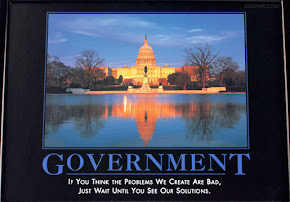Thursday, September 30, 2010
More Economic Bad News: The ‘New Normal’ is Here to Stay
The general premise of this Fiscal Times article is that the 2008-2010 downturn is not an anomaly but the start of a "New Normal", where recovery is not a "certain" and the process of clawing our way back to prosperity will not be a given.
Certainly, we have to improve our education process to ensure that the US has the talent to compete in the world market. Governor Chris Cristie of NJ has the teachers unions in his sights and, if successful, could be a model for our educational revolution.
The Tea Party is taking on big government, challenging the progressive movement and, if successful, over time, will elect candidates that will cut the size of government and reduce spending and the tax burden on our economy. The resultant reduction of our deficits will lessen the inflationary effects on the dollar and give businesses the incentive to invest in the future.
We have a long way to go to dig ourselves out of the hole the Democrats dug by their promotion of sub-prime mortgages and their refusal to recognize the warnings put up by the Bush administration. That hole is deep and still has not bottomed out and the Democrats still do not recognize the dangers to the economy that they are promoting.
Only a return to fiscally responsible, Constitutional government, can save us from the "New Normal" described in this Fiscal Times article.
Excerpt: “Since the birth of the republic, we have been through mishaps much worse than 2008: a revolution that nearly wiped out our credit, a civil war, the libertarian valhalla of the 19th century that saw several depressions as bad as the thirties, the Great Depression itself, and two world wars.”
Over those tumultuous 200 years, the trend in per capita economic growth has been remarkably steady, and so has the return on capital. Stocks have averaged 6 percent a year over inflation since 1802, according to Wharton professor Jeremy Siegel, or 9 percent a year since 1927 according to the oft-quoted Ibbotson survey. American history, in other words, favors optimists.
But what if history is bunk? The America of 2010 — aging, indebted, overextended and under-educated — is not the fresh-faced republic of 1802, with a continent to exploit and a population surging from immigration. Nor is it the victor of WWII, the only developed nation that escaped the war’s destruction. Economic win streaks do come to an end. Just ask Britain. Or Japan.
Washington and Wall Street are coming around to the idea that the economic future we’re stumbling towards will be far less generous from the normality we long for. The “New Normal” — a disarmingly benign term coined by Mohamed El-Erian, co-chief investment officer of the big California investment firm Pimco — envisions a future of sluggish growth, international discord, increased uncertainty and minuscule returns on capital. Government revenues shrink while spending remains high.
The 8 percent historic returns projected into the future by many corporate and state pension funds (and those retirement calculators offered by your 401(k) administrator) never materialize. The fiscal implication: Pension funds that are a trillion dollars underfunded at 8 percent returns actually face shortfalls two or three times as large. And the mind-boggling $6.6 trillion Retirement Income Gap — the difference between what the nation has saved and what it should have saved, as calculated by a coalition known as Retirement USA — may actually be understated.
Now, More Bad News: The ‘New Normal’ is Here to Stay
Certainly, we have to improve our education process to ensure that the US has the talent to compete in the world market. Governor Chris Cristie of NJ has the teachers unions in his sights and, if successful, could be a model for our educational revolution.
The Tea Party is taking on big government, challenging the progressive movement and, if successful, over time, will elect candidates that will cut the size of government and reduce spending and the tax burden on our economy. The resultant reduction of our deficits will lessen the inflationary effects on the dollar and give businesses the incentive to invest in the future.
We have a long way to go to dig ourselves out of the hole the Democrats dug by their promotion of sub-prime mortgages and their refusal to recognize the warnings put up by the Bush administration. That hole is deep and still has not bottomed out and the Democrats still do not recognize the dangers to the economy that they are promoting.
Only a return to fiscally responsible, Constitutional government, can save us from the "New Normal" described in this Fiscal Times article.
Excerpt: “Since the birth of the republic, we have been through mishaps much worse than 2008: a revolution that nearly wiped out our credit, a civil war, the libertarian valhalla of the 19th century that saw several depressions as bad as the thirties, the Great Depression itself, and two world wars.”
Over those tumultuous 200 years, the trend in per capita economic growth has been remarkably steady, and so has the return on capital. Stocks have averaged 6 percent a year over inflation since 1802, according to Wharton professor Jeremy Siegel, or 9 percent a year since 1927 according to the oft-quoted Ibbotson survey. American history, in other words, favors optimists.
But what if history is bunk? The America of 2010 — aging, indebted, overextended and under-educated — is not the fresh-faced republic of 1802, with a continent to exploit and a population surging from immigration. Nor is it the victor of WWII, the only developed nation that escaped the war’s destruction. Economic win streaks do come to an end. Just ask Britain. Or Japan.
Washington and Wall Street are coming around to the idea that the economic future we’re stumbling towards will be far less generous from the normality we long for. The “New Normal” — a disarmingly benign term coined by Mohamed El-Erian, co-chief investment officer of the big California investment firm Pimco — envisions a future of sluggish growth, international discord, increased uncertainty and minuscule returns on capital. Government revenues shrink while spending remains high.
The 8 percent historic returns projected into the future by many corporate and state pension funds (and those retirement calculators offered by your 401(k) administrator) never materialize. The fiscal implication: Pension funds that are a trillion dollars underfunded at 8 percent returns actually face shortfalls two or three times as large. And the mind-boggling $6.6 trillion Retirement Income Gap — the difference between what the nation has saved and what it should have saved, as calculated by a coalition known as Retirement USA — may actually be understated.
Now, More Bad News: The ‘New Normal’ is Here to Stay
Subscribe to:
Post Comments (Atom)






























No comments:
Post a Comment